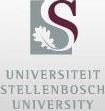Prof Richard Pitcher, Head of the Division of Radiodiagnosis and Executive Head of the Department of Medical Imaging and Clinical Oncology at Stellenbosch University, delivered his inaugural lecture on Thursday 12 October 2023. The title of his lecture was “Radiology in my lifetime – every day a new diagnostic dawn".
Pitcher spoke to the Corporate Communication and Marketing Division about how his work in radiology (diagnosing and treating diseases using various images of parts of the body) helps to advance health equity in Africa.
Tell us more about your research and why you became interested in this specific field.
My research has broadly addressed imaging challenges on the African continent and was jointly inspired by the University's vision for internationalisation and by the global health perspectives of my former Dean, Professor Jimmy Volmink.
The work was prompted by the realisation that the major radiological advances in my lifetime, such as the introduction of ultrasound, computed tomography and magnetic resonance imaging, have paradoxically contributed to increased inequality in global access to imaging. On one end of the global spectrum are well-resourced countries with abundant state-of-the-art equipment, where the main challenge is excessive and inappropriate use of imaging, while on the other end, an estimated two thirds of the world's population lack even the most basic radiological services.
The World Health Organisation suggests that one plain X-ray and ultrasound machine for every 50 000 people will address 90% of all radiological needs. However, back in 2010, at the start of my Stellenbosch University career, I could find no detailed data on radiological resources in Africa. I set out to address this knowledge gap, in collaboration with national departments of health and regulatory authorities across the continent. To date, we have published extensively on African radiological resources. These country-level resource data are the most granular for any global region and have provided the benchmark for similar work in other regions.
An extension of this work has been research on the utilisation of existing radiological resources, which is also poorly understood globally. We have recently completed a series of collaborative projects in this domain with the Western Cape Government, utilising the province's uniquely comprehensive radiological data.
How would you describe the relevance of your work?
The work speaks directly to the clarion call for health equity as contained in the United Nations 2030 Sustainable Development Goals.
You have spent many years in the challenging environment of higher education. What keeps you going when things get tough?
The Faculty and the University have been an exceptionally supportive environment, sustaining one through turbulent times. The collaborative network that has evolved between academic radiology departments across the country has also been of inestimable value.
What do you like most about your work?
The institutional responsibilities of an academic head of department in a South African medical faculty are broad, encompassing clinical work, teaching, research and management. The position also offers unique opportunities for collaboration at national and international level. I have found the breadth and variety of the work and the opportunity to interact with so many groups, at the various levels of healthcare, deeply satisfying.
What is your message to young aspiring diagnostic radiologists?
Do not underestimate the profound satisfaction of an academic career in healthcare in this country.
Tell us something exciting about yourself that people would not expect.
My daily exercise is a 40-minute outdoor swim, throughout the year. (People would probably not find this very exciting, but perhaps unexpected!)
How do you spend your free time?
My favourite pastime is a long walk with my wife, Stevie, and our Staffordshire bull terrier, Baxter (and anyone else happy to tag along), on any of the countless spectacular routes (forest, mountain, coast) around the Peninsula.

